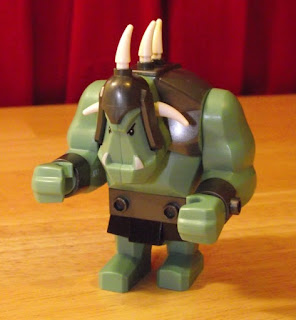Skeletons and Ghosts
The most readily available LEGO undead are skeletons and ghosts, which first appeared in Castle sets and have been featured in various forms in many other themes since then. Some version of these two monsters are almost always in production in one theme or another.
 |
| Skeletons, and droids as quadruped skeletons |
Some sets have included skeletal horses, in both white and black, and the LEGO Cuusoo Research Institute included a brick-built dinosaur skeleton. The Ninjago LEGO game included skeleton microfigures, perfect for smaller reanimated corpses such as kobolds or goblins.
The skeleton of a dog, wolf, or similar-sized quadruped is easy to make: take a Star Wars soldier-droid, remove its weapon and backpack, and bend it down onto all fours (see the photo).
 |
| Peeves (Harry Potter) and classic ghost (Castle) |
 |
| Example of a custom-built ghost |
If you lack any of these ghostly characters, a skeleton head on a white body works well (as will other white heads such as Asajj Ventriss or the Minifigures geisha and mime). For the ghosts of creatures that are not Medium humanoids, build the model in a uniform white, light gray, or transparent colors to show that it's incorporeal.
Mummies, Vampires, and Zombies
The other types of undead that have appeared in LEGO form include mummies, vampires, and zombies.
Mummy: The first LEGO mummies appeared in the Adventurers and LEGO Studios sets. The Pharaoh's Quest theme included a variety of mummies--even winged ones! More recently, Monster Fighters and Minifigures Series 3 and 14 have each included a mummy. Mummy microfigures appeared in the LEGO Games Ramses Pyramid and Ramses Return.
 |
| Snape and vampire |
Zombie: The first LEGO zombie appeared in Minifigures Series 1, followed soon after by some zombie crewmen in the Pirates of the Caribbean theme. The Monster Fighters theme offered additional zombies, and more recently, Minifigures Series 14; Monsters! included three new zombies (pirate, businessman, and cheerleader). There is also an alien Geonosian Zombie in the Star Wars theme,
 |
| Zombie crewmen (Pirates of the Caribbean) |
Other Undead
Fantasy RPGs include many more kinds of undead that haven't appeared in LEGO form. I will give a few suggestions here for how to build figures for them, but I'm limiting the list to those found in the D&D Monster Manual and first Pathfinder Bestiary.
Incorporeal Undead: Most incorporeal undead, such as spectres, can use the same suggestions above for ghosts. (See also the brick-built apparitions in the photo at the top of this column.)
For shadows, allips, and wraiths, you'll need a darker minifigure. A Ringwraith is an ideal choice here, but any all-black minifigure (preferably with little or no printing) will do nicely, as will a Dementor.
 |
| Custom-built devourer |
Ghoul: The best matches that I've found for ghouls are zombies and Gollum. The latter captures the ghoul's emaciated, hunched, predatory look quite well!
Lich: Minifigures such as the Witch-King (Hobbit) or Emperor Palpatine (Star Wars) can be used as-is for a lich. Lacking those, use a skeleton, zombie, or mummy, but give it sorcerer's robes, Pharaoh's regalia, or other suitably arcane and sinister gear to make it obvious that this is a much more dangerous foe.
 |
| Mohrg (modified skeleton) |
Wight: A wight is similar to a zombie or mummy in that it's a corporeal husk of a body. Either of those monsters will do, but I prefer black minifigures with scary heads, such as Darth Maul (Star Wars), Lord Garmadon or the Stone Army (Ninjago). Garmadon has the added benefit of being bony without being a skeleton.
I may tackle additional undead monsters in future columns, but that's all for this installment. I hope these suggestions inspire your designs for your own games!









